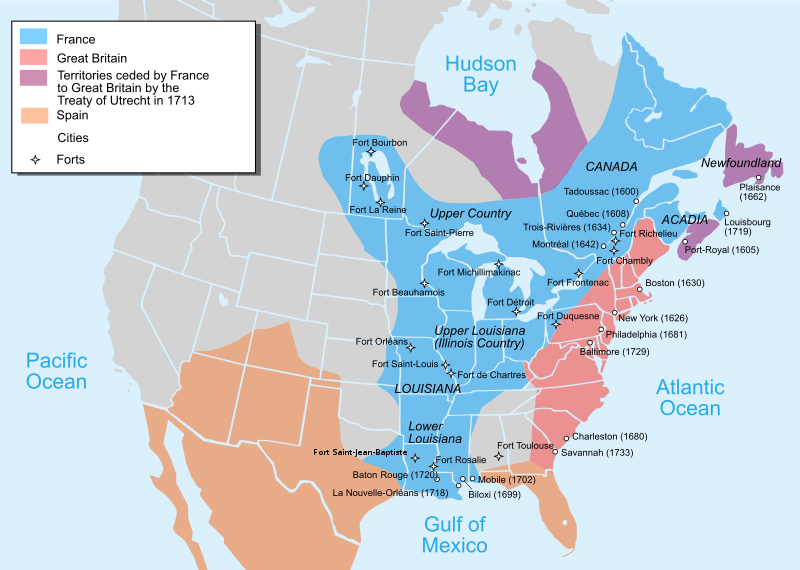
Map of New France (blue) in 1750AD. Notice that the French claim is anchored by scattered forts and only the occasional town. This in contrast to British North America. A larger version is found here: http://upload.wikimedia.org/wikipedia/commons/b/b0/Nouvelle-France_map-en.svg
- Acadia (1604): The coastal areas called Acadia were settled by the French in this period – 1605 is sometimes quoted for the founding of Port-Royal in what is now Nova Scotia (though they left the area from 1607-1610). The French had interests in the East Coast for some time, with fishermen coming to the area of the Atlantic Provinces of modern Canada for some years. While much of mainland Acadia and Newfoundland was ceded to Britain in 1713 by the Treaty of Utrecht, the French held onto Ile Royale (Cape Breton Island) with its fortress of Louisbourg until the mid-18th century.
- Quebec [Canada] (1608): The first serious attempt at setting up a colony, not just an outpost for the French crown, came with the leadership of Samuel de Champlain, the explorer and founder. He founded the city of Quebec in 1608 on the St. Lawrence River. This would remain the capital and center of New France until its fall in the French and Indian War to the English. The cities of Trois Rivieres (1634) and Montreal (1642) to the west of Quebec would also be important cities and centers, each with their own local governor. This area was mainly focused on the fur trade. French Jesuits, did, however, work on the conversion of the locals (Cf., St. Isaac Jogues and St. John de Brebeuf) and French explorations unlocked the Great Lakes and upper Midwest. Notable was the journey of the Jesuit Marquette and Joliet in 1673 down the Mississippi, as far as Arkansas, coming from Lake Michigan. A Bishop, the first being Blessed Francis de Laval de Montmorency, was appointed in 1658, and then a diocese was formed at Quebec City in 1674AD.
- Plaisance [Newfoundland] (1655): This was the seat of the governors of the French colony in the island of Newfoundland. The French would contend with the British over control of the island. It would be ceded to Great Britain in 1713 with the Treaty of Utrecht.
- Louisiana (1699): La Salle, the French explorer, reached the mouth of the Mississippi in 1682, naming this river basin for the king, Louis XIV: Louisiana. It would first see settlement under Iberville at Biloxi [MS] in 1699, and, under his brother Bienville, at Mobile [AL] in 1710, and New Orleans in 1718 (which became the capital in 1723). This gave the French control of the Mississippi, and added to their St. Lawrence and Great Lakes presence: they had a solid claim to the interior of North America with its fur trade. In 1717, the Illinois country, or "upper Louisiana" was formally "incorporated administratively to the colony of Louisiana." [Chartrand, The Forts of New France, 6]

Organizational Chart for the Governance of New France. It is a fascinating contrast with that of the English colonies of North America. You can see a bigger version here: http://upload.wikimedia.org/wikipedia/commons/0/01/Constitution-of-new-france-1759.png
- Governance
of New France: The French had a practice of sparse settlement (there were but 3,215 French in 1666), with
scattered forts for trading and Jesuit missionary work with the
Indians. The entire viceroyalty was ruled by a Governor-General
(responsible for Defense [Marines], Trade, Industry, and Roads) who was resident at Quebec [pop. in
1666, 547], along with an Intendant (who was responsible for Public Works, Finances, and Courts), a Bishop, and a Supreme Council (presided over by the Intendant, and serving as
Supreme Court of the Viceroyalty), while local governors managed affairs
and local militias in Trois Rivieres [pop. in 1666, 455], Montreal [pop.
in 1666, 625], Acadia [later just Ile Royale], Louisiana, and Plaisance [Newfoundland].
A few sources that I found most useful for this: American Colonial and Revolutionary History by Smelser, Colonial American Troops by Chartrand; and Forts of New France by Chartrand.
Live well!
No comments:
Post a Comment